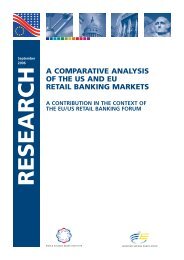Corporate Governance and Access to Finance - ESBG
Corporate Governance and Access to Finance - ESBG
Corporate Governance and Access to Finance - ESBG
You also want an ePaper? Increase the reach of your titles
YUMPU automatically turns print PDFs into web optimized ePapers that Google loves.
The table captures the essence of savings banks, that pursue at the sametime returns <strong>to</strong> their balance sheet <strong>and</strong> returns <strong>to</strong> the society. They contribute<strong>to</strong> the improvement of living conditions, regional development <strong>and</strong>enhanced competition in the banking marketplace.Two of the abovementioned goals are crucial for the purpose of thisstudy: promoting access <strong>to</strong> financial services <strong>and</strong> profit maximization.Empirical findings show that the broadening of their outreach by savingsbanks does not have a cost in terms of lower profitability (see WSBIPerspectives 52, 2006, for a review). The lack of systematic variation inprofitability as outreach increases is a key element <strong>to</strong> underst<strong>and</strong> thatsavings banks or WSBI members more generally can achieve goals formultiple stakeholders, including shareholders when they exist, deposi<strong>to</strong>rs,the public sec<strong>to</strong>r or members of a mutual society in its case.The traditional approachAccording <strong>to</strong> traditional studies, the main recommendations for<strong>Corporate</strong> <strong>Governance</strong> in firms in general apply also <strong>to</strong> bankinginstitutions, as documented by La Porta et al (2002), namely that betterresults are obtained in countries where there are mechanisms <strong>to</strong> ensureprotection of minority shareholders. Caprio et al (2007), however, arguethat the moni<strong>to</strong>ring by small shareholders could be difficult in the caseof banks, even under strong shareholder protection regimes, due <strong>to</strong>the opaque nature of their activity, the lack of information on specificborrowers <strong>and</strong> their inherent liquidity vulnerability. Their findings, though,do not differ from those of non banking firms: controlling owners withlarge cash-flow rights <strong>and</strong> strong shareholder protection make bankingfirms more valuable. These empirical findings are resulting from a datasetwith the 10 largest publicly listed banks across 44 countries. It is notpossible <strong>to</strong> derive direct implications for banking firms with no explici<strong>to</strong>wners, like mutual societies, or with a complex structure of cash flowrights, as many savings banks. For a review of <strong>Corporate</strong> <strong>Governance</strong>practices in the case of mutual societies see Llewellyn (2007).Government intervention promoting high disclosure st<strong>and</strong>ards <strong>and</strong>market discipline is one of the main <strong>to</strong>ols <strong>to</strong> combat the opacity offinancial institutions. Bank transparency would enhance market discipline<strong>and</strong> counteract uncertainty. Transparency would also reduce moralhazard, exacerbated by the government guarantees on bank liabilities, asthe current crisis has shown.101
















